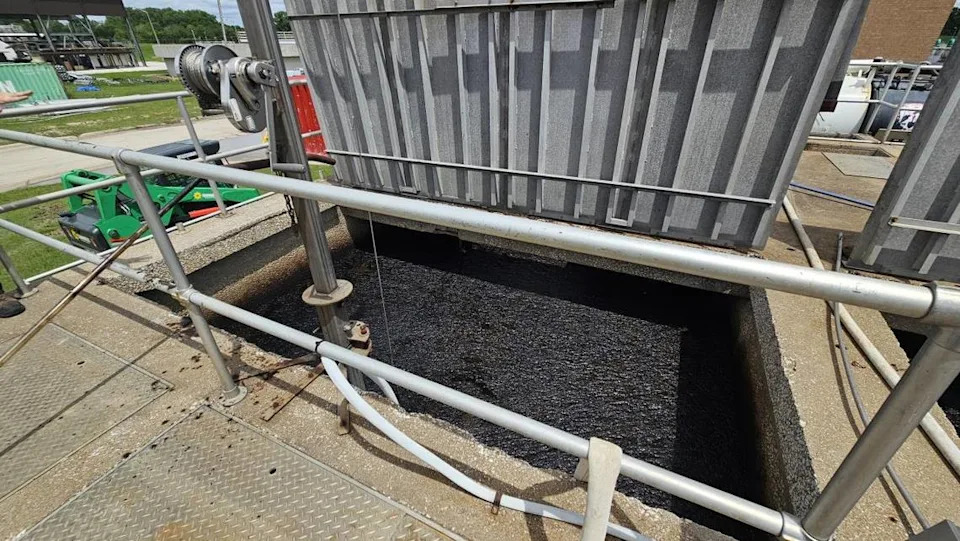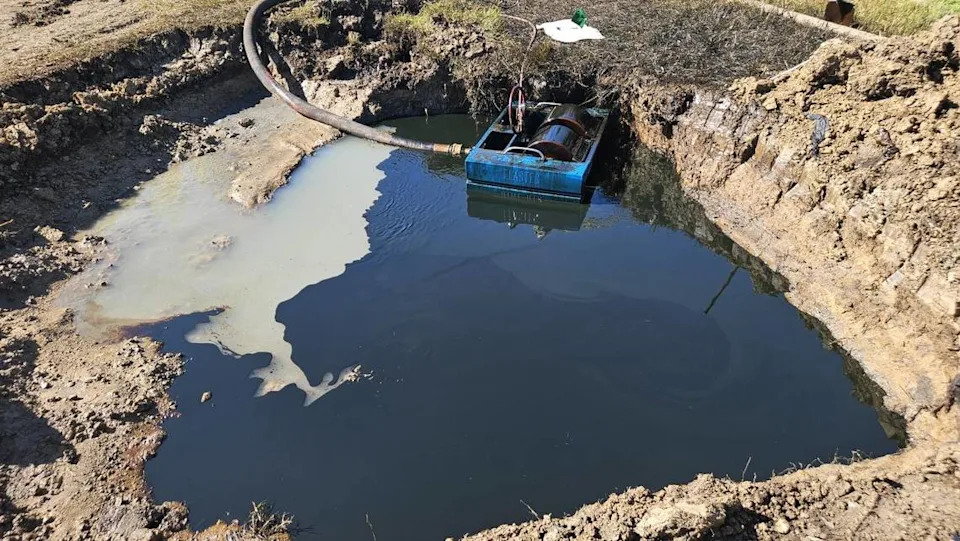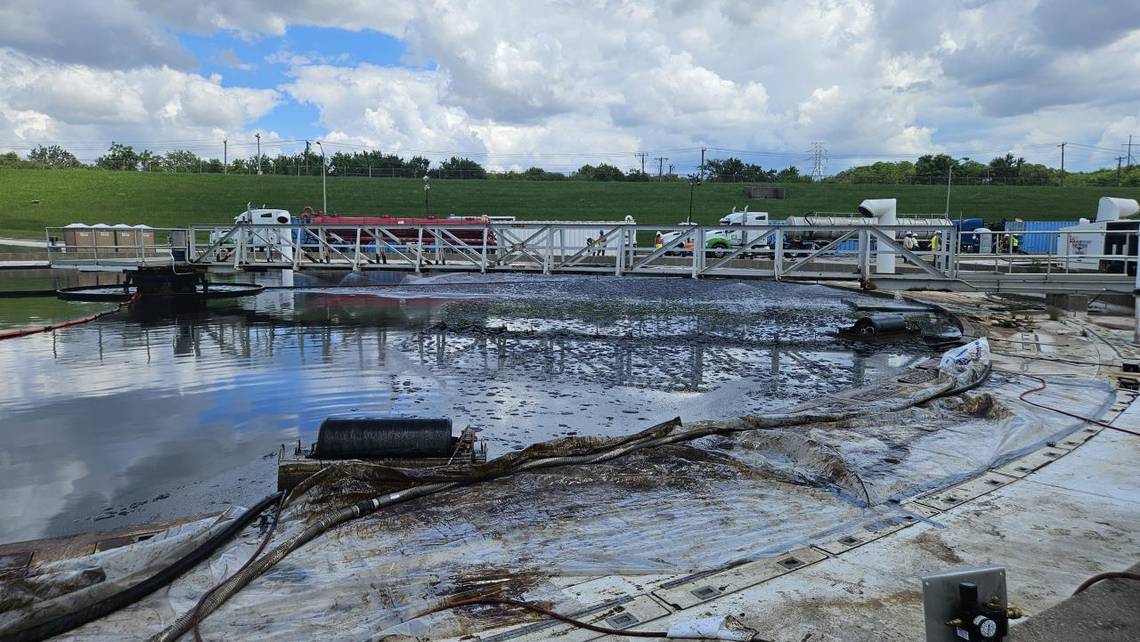The Fort Worth water department is using former drying beds to clean wastewater contaminated with oil from a spill near Lake Arlington in May.
A damaged pipe just north of the lake leaked 2,600 barrels of crude oil in early May, according to a report by the Environmental Protection Agency. The oil entered a municipal sewer line owned and operated by the city of Fort Worth.
The EPA was notified by its National Response Center of around 20 barrels discharged on May 6. That number was updated the following day.
The damaged pipe is on the south side of East Lancaster Avenue, about three-fourths of a mile west of Green Oaks Boulevard. The Dallas-based pipeline company Energy Transfer is listed as the responsible party in the report.
Energy Transfer did not immediately respond to a request for comment.
EPA officials traced the discharge to the Village Creek Wastewater Treatment Plant on Northwest Green Oaks Boulevard, just north of Interstate 30. They observed crude oil in aeration basins, final clarifiers — large tanks where solids settle to the bottom — and the fats, oils and greases handling facility, where oils and floating solids are skimmed off the top of the wastewater.
“Oil sheening and strong petroleum odors were observed in the aeration basins,” the report states.
They also observed a “very light sheen” on the water where the facility discharges treated water into the West Fork of the Trinity River, but no recoverable oil was found on the water surface or vegetation near the site.
Old wastewater drying beds used to clean contaminated water
The Village Creek Drying Beds, about a mile northeast of the treatment plant, are being used to dry out the waste activated sludge — a byproduct of the water treatment process — that was contaminated by the oil, the Fort Worth water department said in a statement.
“The vast majority of the oil was contained within the plant’s primary treatment area and safely removed by environmental contractors,” said Fort Worth water utility spokesperson Mary Gugliuzza in an emailed statement. “That material was then transported to one of the oil pipeline company’s facilities for reclamation.”

Crude oil floats on top of the water in a fats, oils and greases tank at the Village Creek Wastewater Treatment Plant on May 8, 2025.
Before the installation of the treatment plant, the drying beds were used to treat sewage. Wastewater was set out to evaporate in the beds, then the dried solids were hauled away and used as fertilizer.
“Unfortunately, small amounts of residual oil did make it further into the treatment system, which disrupted our biological treatment process,” Gugliuzza said. “Specifically, it affected the beneficial microbes — also known as biomass or activated/waste activated sludge — that play a critical role in removing soluble organics found in domestic wastewater.”
Although no longer in use, the drying beds are popular with migrating waterfowl and the local birdwatchers who enjoy observing them. The city allowed birders to conduct their activities on the property in the past, but the site has been closed to the public since May to “protect the health and safety of the public, as well as the workers involved,” Gugliuzza said.
The city has observed signs of trespassing and vandalism at the site, including cut fences and tracks from motorcycles and all-terrain vehicles, which has “highlighted regulatory and liability risks to the city, as well as safety concerns to the public,” she said. These also played a role in the decision to close the drying beds off to the public.
The city will continue to restrict public access for the foreseeable future, but will look into ways to allow “limited and temporary access” to wildlife groups.
“We appreciate the community’s understanding and support as we work to restore full operations and improve access policies with plant operational flexibility and safety in mind,” Gugliuzza said.
‘Always something in the air’ in Arlington
Hundreds of oil and gas sites pepper the area around the site of the spill, including the Handley Generating Station, a natural gas power plant about a mile and a half to the west.
Ranjana Bhandari, a resident and activist with the environmental advocacy organization Liveable Arlington, said she often smells odors of petrochemical production in the area.
“In this part of Arlington and Fort Worth, there’s always something in the air,” she said.
The EPA performed air monitoring in the vicinity of the spill, but did not find high levels of pollutants like carbon monoxide, hydrogen sulfide, volatile organic compounds and others.

Crude oil pools at the site of a damaged pipeline north of Lake Arlington on May 8, 2025. The leak of 2,600 barrels occurred two days prior and contaminated wastewater in the Fort Worth sewer system.
But for Bhandari, the spill represents the broader threat to public health presented by oil and gas production in the area.
“There are a lot of neighborhoods close by, so this just represents one more source of pollution and other risks to air we breathe, perhaps to ground water, as this incident shows, and to health and safety,” she said. “At some point, I think at every level of government, there should be an accounting of how many different sources of oil and gas pollution there are concentrated in Arlington and neighboring cities, and what kind of threats they pose, and maybe we should not be adding to them.”
The EPA said in a statement sent after publication that no “significant environmental impacts were detected around the incident area,” and that any residents with concerns about their water quality can contact the city of Fort Worth and/or the Texas Commission on Environmental Quality. As for any possible fines or sanctions on the company responsible, the EPA spokesperson said the agency cannot comment on potential or ongoing enforcement actions.
According to a pipeline map maintained by the U.S. Pipeline and Hazardous Materials Safety Administration, a “hazardous liquid pipeline” runs in a north-south direction at the site of the spill.
That administration did not immediately respond to a request for comment.
How will oil spill cleanup affect migrating birds?
As for the birds who stop of at the ponds during their migrations and others who stay year-round, Gugliuzza said the city has not observed any issues with waterfowl interacting with the waste-activated sludge. They tend to stay in the ponds at the east side of the site, and the sludge is in beds at the other end.
Chuck Baskin, president of the Fort Worth Audubon Society, confirmed the migrating birds’ preference for the ponds on the east side.
“That area is well removed from the sludge that is drying,” he said.
Michael Francis, who edits the society’s newsletter, also said that birds tend to steer clear of the sludge, except when drawn by hunger.
“It’s not likely one would drop in on the stuff unless something lured it there,” he said in an email, adding that a hawk reportedly entered the sludge going after prey. It was captured and taken to a rehabilitation center for cleanup.
Baskin said some species like sandpipers like to root around for insects in pools of standing water and they may get into contaminated puddles when they migrate back through in August and September. But he was unable to detail the extent of the potential threat to wildlife.
“Whether the stuff out there now is very toxic or not we don’t know,” Baskin said. “Until it dries enough to be removed there will be some level of concern.”
The Star-Telegram left voicemails with members of the Texas Parks and Wildlife Department’s Kills and Spills Team, which investigates the effects of pollution incidents, but did not immediately get a response.
